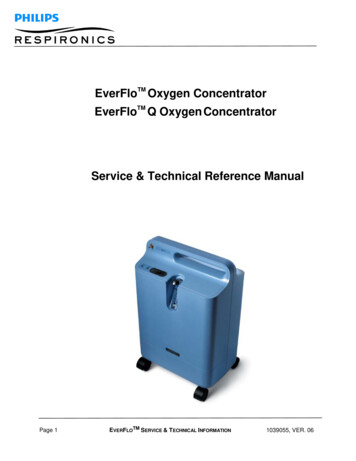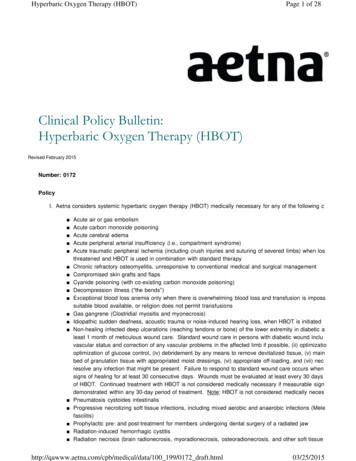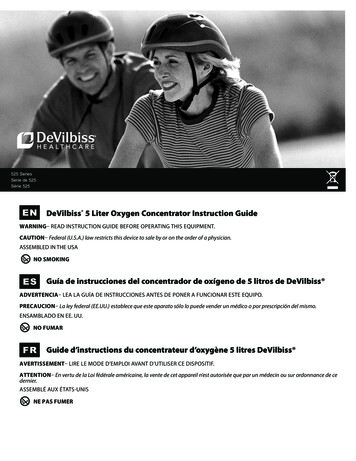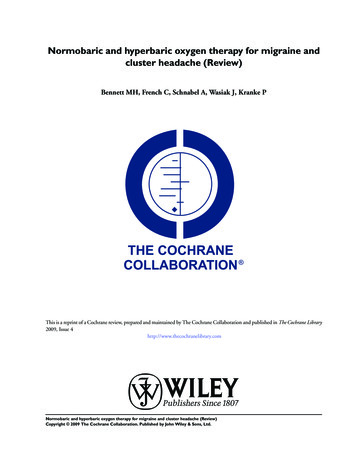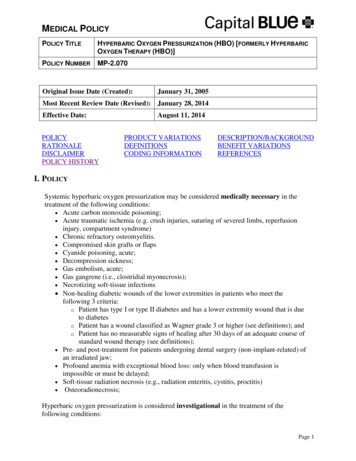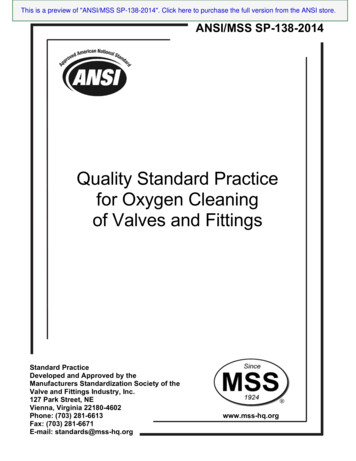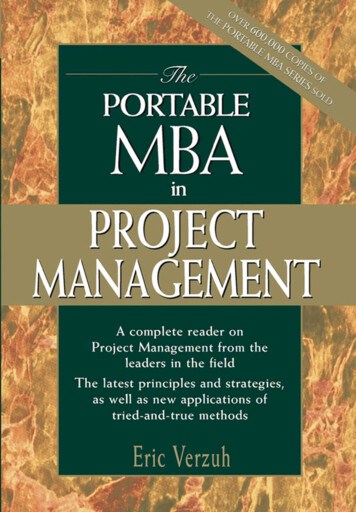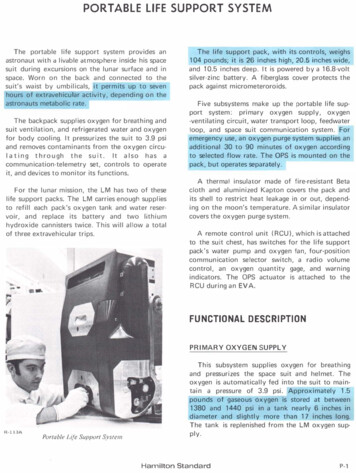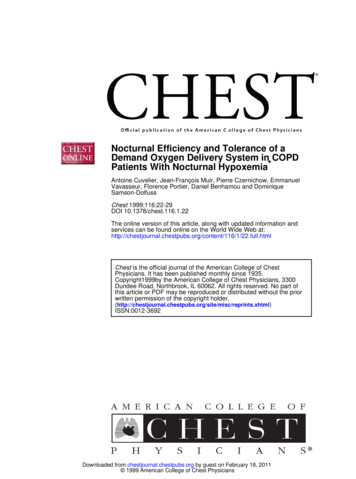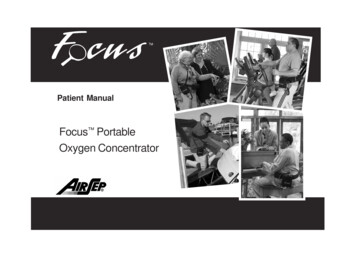
Transcription
Patient ManualFocus PortableOxygen Concentrator
DO NOT OPERATE THIS EQUIPMENT WITHOUT FIRST READING AND UNDERSTANDINGTHIS MANUAL. IF YOU ARE UNABLE TO UNDERSTAND THE WARNINGS ANDINSTRUCTIONS, CONTACT YOUR EQUIPMENT PROVIDER BEFORE ATTEMPTING TO USETHIS EQUIPMENT; OTHERWISE, INJURY OR DAMAGE CAN RESULT.NO SMOKING signs should be prominently displayed in the home or wherever Focus is in use. Proper informationabout the dangers of smoking in the presence of medical oxygen should be relayed.English: A multilingual version of the manual (MN172-1) is available through your Equipment Provider.Español: Una versión multilingüe del manual (MN172-1) está disponible a través de su proveedor de equipo.Français: Une version multilingue du manuel (MN172-1) est disponible par l'intermédiaire de votre fournisseur de matériel.Deutsche: Eine mehrsprachige Version des Handbuchs (MN172-1) ist in Ihrer Geräte-Anbieter.
TABLE OF CONTENTSAirSep Focus PortableOxygen ConcentratorAirSep’s Focus PortableOxygen Concentrator1Symbols1-2Why Your Physician Prescribed Oxygen2What is the Focus PortableOxygen Concentrator?3Important Safety Rules4-7Getting Started with YourFocus Portable Oxygen Concentrator8-11Battery Charging12Optional AirBelt / Charging the Optional AirBelt13-15Nasal Cannula16-17Focus Unit Components17Operating Instructions18Power Supplies19
TABLE OF CONTENTSAirSep Focus PortableOxygen ConcentratorAudible Alarm and Indicator Lights20-21How to Respond to Focus’s Audible Alarm andIndicator Lights22Cleaning, Care, and Proper Maintenance23Cabinet23Carrying Bag23Focus Accessories24Reserve Oxygen Supply24Troubleshooting25-26Focus Specifications27Classification28Limited Warranty29
AirSep’s Focus Portable Oxygen ConcentratorThis Patient Manual wil l acquaint you with Air Sep’s Focus Portable Oxygen Concentrator (POC). Ma ke sure you r ead andunderstand all the inform ation contained in this m anual before you operate your Focus unit. Should you ha ve any questions, yourEquipment Provider will be happy to answer them for you.SymbolsSymbols are frequently used on equipment and/or the m anual in preference to words with the intention of decreasing thepossibility of m isunderstanding caused by la nguage differences. Sym bols can also perm it easier com prehension of a conceptwithin a restricted space.The following table is a list of symbols and definitions used with the Focus Portable Oxygen Concentrator.SymbolDescriptionON (power switch on)Warning – Describes a hazard or unsafeDescriptionOFF (power switch off)practice that if not avoided can result insevere bodily injury, death or propertydamageClass II Equipment, double insulatedCaution – Describes a hazard or unsafeComplies with the 93/42/EEC directivedrawn up by the approved organizationNo. 0459Note – Provides information importantenough to emphasize or repeatSafety agency for CAN/CSA C22.2 No.601.1 M90 for medical electricalequipmentConsult the accompanyingdocumentsKeep unit and accessories drypractice that if not avoided can result inminor bodily injury or property damageUse no oil or greaseMN170-1 rev A 03/11SymbolProper disposal of waste of electrical andelectronic equipment required1
No smokingDo not disassembleType BF equipmentConsult instructions for useOxygen outlet connection to thecannulaDo not expose to open flamesCaution: Federal law (USA) restrictsthis for sale or rental by or on the orderof a physician or licensed health careprovider.Do not block fanMethod of disposing of waste: All waste from AirSep’s Focus Oxygen Concentrator must be disposed of using the appropriatemethods specified by local authorities.Method for disposing of the device: In order to preserve the environment, the concentrator must be disposed of using the appropriatemethods specified by local authorities.Why Your Physician Prescribed OxygenMany people suffer from a variety of heart, lung, and other respirat ory diseases. A significant nu mber of these patients can benefitfrom supplemental oxygen therapy at home, when traveling, or while participating in daily activities away from home.Oxygen is a gas that m akes up 21% of the room air we breath e. Our bodies depend on a steady supply to function properly. Yourphysician prescribed a flow or setting to address your particular respiratory condition.Although oxygen is a non-additive drug, unauthorized oxygen therapy can be dangerous. You must seek medical advice before you usethis oxygen concentrator. The Equipm ent Provider who supplies your oxygen equipm ent will demonstrate how to operate the FocusPortable Oxygen Concentrator.MN170-1 rev A 03/112
What is the Focus Portable Oxygen Concentrator?Oxygen concentrators were introduced in the mid-1970s and have become the most convenient, reliable source of supplemental oxygenavailable today. Oxygen concentrators are th e most cost-effective, efficient, and safe st alternative to using high-pressure ox ygencylinders or liquid oxygen. An oxygen concentrator provides all the oxygen you need with no cylinder or bottle deliveries required.The air we breathe contains approximately 21% oxygen, 78% nitrogen, and 1% other gases. In the Focus unit, room air passes thro ugha regenerative, adsorbent material called molecular sieve. This material separates the oxygen from the nitrogen. The result is a flow ofhigh-concentration oxygen delivered to the patient.Focus combines advanced oxygen concentrator technology with oxygen conserving technology for the world’s smallest and lightestportable oxygen concentrator at just 1.75 lb (0.8 kg). The unit efficiently produces its own oxygen, and quickly delivers it as a pulseof oxygen at the very beginning of your inhalation. This eliminates the waste associated with a continuous flow oxygen device thatdelivers oxygen even while you are exhaling. Focu s produces the equivalent of 2 LPM (liters per m inute) continuous flow oxygenin a lightweight package that patients can wear easily away from the home.Focus operates from four different power sources. (Refer to the Power Supplies section of this manual.)MN170-1 rev A 03/113
---- [Read the Important Safety Rules section before operating this equipment.] ---Important Safety RulesCarefully review and familiarize yourself with the following important safety information about the portable Focus OxygenConcentrator.This device supplies high-concentration oxygen that promotes rapid burning. Do not allow smoking or open flameswithin five feet (1.5 m) of this device, or any oxygen-carrying accessory. Failure to observe this warning can result insevere fire, property damage, and/or cause physical injury or death.If you feel discomfort or are experiencing a medical emergency, seek medical assistance immediately.This unit is not to be used for life support. Geriatric, pediatric, or any other patients unable to communicate discomfortwhile using this unit may require additional monitoring. Patients with hearing and/or sight impairment(s) may needassistance with monitoring alarms.Use no oil, grease, or petroleum-based or other flammable products on the oxygen carrying accessories or the Focusunit. Oxygen accelerates the combustion of flammable substances.The incorrect use of the Focus battery can cause the battery to get hot, ignite, and may cause serious injury. Be surenot to pierce, strike, step on, or drop the battery, or otherwise subject the battery to strong impacts or shocks.While using the Focus unit outdoors with the AC power supply, connect the power supply into a Ground FaultInterrupted (GFI) outlet only to prevent accidental electrical shock hazard.Electrical shock hazard. Disconnect the power cord from the electrical outlet before you clean the unit to preventaccidental electrical shock hazard. Only your Equipment Provider or a qualified service technician should remove thecovers or service the unit.MN170-1 rev A 03/114
Care should be taken to prevent Focus from getting wet or allowing water to enter the unit. This can cause the unit tomalfunction or shut down.Federal (USA) law restricts this device to sale or rental by order of a physician or other licensed health care provider.In the event of an alarm or you observe that Focus is not working properly; consult the Troubleshooting section in thismanual. If you cannot resolve the problem, consult your Equipment Provider.The Focus Portable Oxygen Concentrator may be used during sleep under the recommendation of a qualified clinician.Operating the Focus unit outside of its normal operating temperature range can affect performance and decreasebattery run time and/or increase battery charge time. (Refer to the Specifications section in this manual.)Do not allow either the air intake or the air outlet vents to become blocked. This can cause the Focus unit to overheatand affect performance.Do not operate unit in a restricted or confined space (i.e., a small case or handbag) where ventilation can be limited.This can cause the Focus unit to overheat and affect performance.Storing the Focus unit outside of its temperature specifications may affect performance. (Refer to the Specificationssection of this manual)When using Focus in an automobile, boat, or on other DC sources with the DC power supply, make sure that the vehicleis started and running before connecting the Focus unit. If the DC power supply does not illuminate and requires resetting,disconnect the DC power supply from the DC outlet, restart your vehicle, and then reconnect your DC power supply intothe DC outlet. Failure to follow these instructions can result in the power supply not supplying power to Focus.MN170-1 rev A 03/115
When the automobile in which you are using the Focus unit is turned off, disconnect and remove the unit from theautomobile with you. Do not store Focus in a very hot automobile or in other similar, high-or low-temperatureenvironments. Operating or storing the unit outside the normal temperature range can affect the performance of theFocus. (Refer to the Specifications section in this manual.)If the Focus has been stored for an extended period of time outside its normal operating temperature range, the unitshould be allowed to return to normal operating temperature before being turned on. (Refer to the Specificationssection in this manual.)Storing your Focus battery for extended periods of time at high temperatures or with a fully charged/completelydischarged battery can degrade its overall battery life.Depending upon the temperature of the Focus battery, it can take several minutes for the charging cycle to start afterconnecting to power. This is a normal condition and is intended for safe charging.The Focus battery does not need to be fully discharged before recharging. It is recommended to charge the Focusbattery after each use.If the Focus power supply remains connected when the battery is fully charged, the four LEDs will turn off within ½hour.Cannula tubing must be non-kinking, which can be used for a total length of up to 25 ft (7.6 m) maximum.NO SMOKING signs should be prominently displayed in the home or wherever Focus is in use. Proper information aboutthe dangers of smoking in the presence of medical oxygen should be relayed.MN170-1 rev A 03/116
Important Safety Rules for Optional AirBeltThe incorrect use of AirBelt can cause the battery to get hot, ignite, and can cause serious injury. Be sure not to pierce,strike, step on, or drop the battery, or otherwise subject the battery to strong impacts or shocks.Replace safety cap on AirBelt cord when not in use.Do not attempt to charge the optional AirBelt with the Focus power supply or AirBelt can be damaged.Use only the AirBelt power supply provided to charge AirBelt.Do not allow Focus or AirBelt to be stored in a very hot automobile or in other similar, high- or low-temperatureenvironments. Operating AirBelt outside the normal temperature range can affect the performance.(Refer to the Specifications section in this manual.)Storing your AirBelt for extended periods of time at high temperatures or with a fully charged or completely dischargedbattery can degrade its overall battery life.Depending upon the temperature of the Focus battery, it can take several minutes for the charging cycle to start afterconnecting to power. This is a normal condition and is intended for safe charging,AirBelt does not need to be fully discharged before recharging. It is recommended to charge AirBelt after each use.If the AirBelt power supply remains connected when AirBelt is fully charged, the four LEDs will turn off within ½ hour.MN170-1 rev A 03/117
[Read the Important Safety Rules section before operating this equipment.]Getting Started with Your Focus Portable Oxygen ConcentratorThe Focus packaging contains the following items, as shown below. If any items are missing, contact your Equipment Provider.1) Focus unit with carrying bag.2) Coil Cord w/Switch, connects battery to Focus3) Battery Pack, Lithium Ion/Rechargable (2 supplied)4) Battery case5) Universal Power Supply (AC/DC)6) AC Power Cord7) DC Power Cord8) Coil Cord without switch, connects battery to power supply only9) Focus Belt10) Focus shoulder strap11) Patient Manual (not shown)1324Figure 1: Focus with Battery697Figure 3: Focus belt5108Figure 4: Focus shoulderFigure 2: Focus PowerSupply with DC Input Cordand adapterMN170-1 rev A 03/118
Before operating Focus for the first time, familiarize yourself with the major components. These are illustrated in the Figures onthe following pages and discussed later in the manual.Connecting to the Focus Power Inlet:Locate the arrow marking at the top of the connector. Insert connector (Figure 5) into the Focus power inlet ( Figure 6) with thearrow on the side of the connector facing outward. Do not force the connector into the power inlet, as it can be inserted only oneway. This ensures that neither the unit nor the power accessories are damaged.Focus unit’spower inletFocus unit’spower connectorFigure: 5Figure: 6Focus operates from four different power sources.NOTE: Always connect to the Focus power inlet first before connecting to a power supply.1) Connecting Focus to AC electrical power:When you are near an AC outlet, you may choose to operate Focus with the universal power supply rather than the battery.Connect the cord on the power supply labeled as DC OUT To Focus into the Focus unit’s power inlet,as shown in Figure 7. Do not force the plug, as it should be inserted only one way.From the other end of the power supply, connect the 3-prong AC cord from the power supply into any standard outlet.Focus unit’spower inletFigure: 7DC OUT to FocusMN170-1 rev A 03/119
2) Connecting Focus to a DC power source:The universal power supply can also be used to operate the Focus unit from any 12-Volt DC power source.For example: to an automobile, (boat, motor home, etc.) with a 12-Volt DC outlet.Connect the power supply cord labeled DC OUT To Focus into the Focus unit’s power inlet, as shown in Figure 8.Place the DC accessory adapter on the end of the DC power cord.Connect the other end into the power supply input connection labeled Accessory DC IN.You can then connect the DC power cord (with adapter attached) into the 12-Volt DC power source.Do not force the cords, as they can be inserted only one way.DC OUT to FocusDC accessory adapterConnect to FocusDC power cordAccessory DC INFigure: 8MN170-1 rev A 03/1110
3) Connecting Focus with the Battery, as shown:Before using the battery, check that it has a sufficient charge.The battery is equipped with a gauge (Figure 9) to indicate the level of battery charge (25-100%). To check the level ofcharge of the battery, press the button on the battery’s keypad. The battery gauge/indicator(s) LEDs to the left of thebutton illuminate to indicate the level of battery charge (25-100%).Connect the switch end of the battery cord into the Focus unit’s power inlet only, as shown in Figures 5 and 6.Connect the other end into the battery. Do not force the cords, as they can be properly inserted only one way.Refer to the instructions on charging the battery in the Battery Charging section.Focus units Power InletBattery GaugeBelt / ShoulderStrap clipFigure: 9Focus is very light weight and easy to wear using the AirSep-supplied shoulder strap (Figure 4), or belt (Figure 3). You may clipthe battery on to either the strap or belt.Focus can be worn on the waist by feeding the AirSep-supplied waist belt (Figure 10) or the optional AirBelt, (Figure 11)through the loops on the back of the Focus unit’s carrying bag. Focus can also be worn over the shoulder with the use of theAirSep-supplied shoulder strap as shown (Figure 12).Figure 10: Focus unit worn on the waistMN170-1 rev A 03/11Figure 11: Focus unit worn with AirBeltFigure 12: Focus unit worn with the shoulder strap11
Battery ChargingCheck to make sure your unit’s battery is fully charged before venturing out with Focus for the first time or upon subsequentuse. To check the level of charge of the battery, press the button on the battery’s keypad. The battery gauge/indicator(s)illuminate to indicate the level of battery charge (25-100%).To charge the Focus battery while using Focus:1a) Using AC Power: Follow the instructions in the Connecting Focus to AC electrical power section.1b) Using DC Power: Follow the instructions in the Connecting Focus with the Battery section.2) Connect the coiled battery cord (no on/off switch) into the power supply outlet labeled DC OUT To Battery. Connect theother end to the battery.Note: The battery is charging whenever the unit operates on AC or DC power. The Focus battery will completely recharge from its fully depleted state in approximately 4 hours, whether the unit is in useon AC or on DC power. While charging a fully discharged battery, the LED will continue to blink until 25% capacity is reached. The LED will thenturn solid. Each of the four LEDs, 25% -100%, will blink as stated above, then turn solid when the battery reaches it’s capacity. When all LEDs illum inate solid, the battery is fully charged and the LEDs will re main solid for a period of time, then allfour LEDs will turn off.DC OUT To BatteryDC OUT to FocusCD032-2Cord for recharging only(no on/off switch)Figure: 13MN170-1 rev A 03/1112
Optional AirBeltOptionally, you may also have an AirBelt for extended use of Focus.The optional AirBelt (Figure 14), can power the Focus unit for up to 4 hours.Before using AirBelt, check that it is sufficiently charged. It requires approximately 3 ½ hours to completely charge.AirBelt is equipped with a battery gauge/indicator to indicate the level of battery charge (25-100%). To check the level ofcharge, press the button on the AirBelt keypad. The battery gauge/indicator(s) illuminate to indicate the level of batterycharge (25-100%). Connect the interface cable (Figure 15) into the AirBelt, then plug the other end of the interface cableinto the Focus, as shown in Figure 16. For proper orientation of the connector, see Connecting to the Focus Power Inletsection.AirBelt batterycharge level(25-100%Figure 15:AirBelt to Focus cordFigure 14:AirBelt batteryMN170-1 rev A 03/11AirBelt toFocusconnectionFigure 16:AirBelt batterywith Focus13
Charging the Optional AirBeltTo charge the AirBelt battery for extended use:1) Release safety cap from end of the AirBelt cord.2) Connect the AC/DC power supply (included with AirBelt Accessory kit) to the end of AirBelt’s power cord, as shownin Figure 17.3) Connect the AirBelt power supply to an AC electrical outlet to recharge.AirBeltConnecting the AirBelt cord to the power supply cordAC/DC Power SupplyFigure 17: AirBelt Battery Charging set-upReplace safety cap on AirBelt cord when not in use.Do not attempt to charge the optional AirBelt with the Focus power supply or the AirBelt can be damaged.Use only the AirBelt power supply provided to charge AirBelt. The Focus AirBelt will completely recharge from its fully depleted state in approximately 3 ½ hours.While charging a fully discharged battery, the LED will continue to blink until 25% capacity is reached. The LED will then turn solid.Each of the four LEDs, 25% -100%, will blink as stated above, then turn solid when the battery reaches it’s capacity.When all LEDs illuminate solid, the battery is fully charged and the LEDs will remain solid for a period of time, then all four LEDs willturn off.MN170-1 rev A 03/1114
The incorrect use of AirBelt can cause it to get hot, ignite, and may cause serious injury. Be sure not to pierce, strike,step on, or drop the battery, or otherwise subject the battery to strong impacts or shocks.Do not store Focus or AirBelt in a very hot automobile or in other similar, high- or low-temperature environments.Operating or storing the AirBelt outside the normal temperature range can affect its performance. (Refer to theSpecifications section in this manual.)Storing your AirBelt for extended periods of time at high temperatures or with a fully charged or completely dischargedbattery can degrade its overall battery life.Depending upon the temperature of the Focus battery, it can take several minutes for the charging cycle to start afterconnecting to power. This is a normal condition and is intended for safe charging.AirBelt does not need to be fully discharged before recharging. It is recommended to charge it after each use.If the AirBelt power supply remains connected when it is fully charged, the four LEDs will turn off within ½ hour.MN170-1 rev A 03/1115
[Read the Important Safety Rules section before operating this equipment]Nasal CannulaA nasal cannula with tubing are used to de liver oxygen from the Focus unit to the user . The tubing is conn ected to the unit’soxygen outlet (See Figure 18).Focus Power InletConnect the Cannula toFocus’s Oxygen OutletFigure: 18AirSep recommends a nasal cannula with 7 ft (2.1 m) of tubing, AirSep Part No. CU002-1, or other suitable cannula. Otherlengths of non-kinking/star channel cannula can be used for a total length of up to 25 ft (7.6 m) maximum.When Focus is operating but does not sense breathing for 15 minutes, a constant alarm sounds, and the amber alarm lightilluminates simultaneously. If this occurs, check the connection from the cannula to the Focus unit, make sure that the nasalcannula is positioned properly on your face, and ensure that you are breathing through your nose. (Your physician mayrecommend the use of a chin strap if needed.) If the alarm condition continues, change to another source of oxygen as available,and contact your Equipment Provider.Always follow the cannula manufacturer’s instructions for proper use. Consult your licensed health care provider todetermine how often the cannula should be replaced.Ensure the cannula is fully inserted and secure. This ensures that the Focus unit can properly detect inspiration foroxygen delivery.MN170-1 rev A 03/1116
Cannula tubing must be non-kinking, which can be used for a total length of up to 25 ft (7.6 m) maximum.Focus Unit ComponentsFocus Control Panel (Top view): Alarm Display and Power InletFocus Power InletAir OutletAlarm IndicatorFigure: 19Bi-color LEDGreen light: On/ Pulse Flow IndicatorAmber light: Alarm and Service IndicatorAir InletFigure 20: Focus Exterior View - FrontLabel/PatientInstructionsFigure 21: Focus Exterior View - BackNow that you are familiar with Focus’s components, review the instructions on the following pages to operate the Focus unit.MN170-1 rev A 03/1117
[Read the Important Safety Rules section before operating this equipment]Operating Instructions1. Locate and position Focus so that the air inlet and outlet are not obstructed.2. Power the unit f rom (a) the battery ; (b) DC outlet (i. e. automobile or motor boat); or (c) an AC outlet (i.e. normhousehold electric). (Refer to the Power Supplies section of this Patient Manual.(Refer to Connecting to Focus’s Power Inlet section for specific instructions on the connection of power sources.)al3. Securely connect your cannula to the oxygen outlet, as shown in Figure 18.Use no oil, grease, or petroleum-based or other flammable products on the oxygen carrying accessories or the Focusunit. Oxygen accelerates the combustion of flammable substances.4. Lift the control panel tab on the unit’s power inlet and connect the selected power source. (i.e., battery, AC or DC powersupply, or optional AirBelt)5. Turn the Focus unit on by pressing the power switch to the on position (l). The LEDs on the contro l panel willilluminate, alternating between green and red, mom entarily. Also, each time you turn on Focus , a brief alarm sounds.This indicates that Focus is powered for use.When Focus senses inhalation, oxygen is supplied to you through your cannula.The time required to reach maximum oxygen concentration after turning on the Focus unit is approximately two minutes.6. To turn Focus off, press the power switch to the off position (0).MN170-1 rev A 03/1118
[Read the Important Safety Rules section before operating this equipment]Power Supplies (Overview)Focus can be powered in four different ways – the battery, AC power, DC power, or an optional AirBe lt. The Focus powersupply functions both as an AC power supply and a DC power supply.(Refer to Connecting to Focus’s Power Inlet section for specific instructions regarding the connection of optionalpower sources.) Battery: Two rechargeable batteries are supp lied with Focus. Each battery, when fully ch arged, supplies power to theFocus unit for up to 1 ½ hours. An audible alarm sounds when the battery power is getting low. T he alarm is discussed inthe Audible Alarm and Indicator L ights section of this manual. The 25% capac ity LED will blink every ½ second toindicate a low state of charge when the button is pressed.During this condition, change to another battery or alternate power source. Battery Charging (Battery Charging section): To charge the battery, connect the ba ttery to either the power supply anda 100-240 volt, 50/60 H z AC power outlet, or connect the powe r supply to a DC power outlet in an autom obile (boat,motor home, etc.). A discharged battery requires approxim ately four hours to f ully charge. It is recomm ended torecharge the battery, even if only partially depleted, as often as possible. Universal Power Supply The AC power supply side of the universal power supply, al lows the Focus unit to connect to a 100-240 volt, 50/60 Hzoutlet. The power supply converts 100-240 volt AC to a DC voltage for the Focu s unit to operate wh ile recharging theFocus battery simultaneously. The DC power inlet on the universal pow er supply, allows the Focus unit to conne ct to a motor vehicle’s 12-Volt DCoutlet for the Focus unit to operate while recharging Focus’s battery simultaneously. Optional AirBelt: Focus can also be powered with AirBelt. AirBelt can be worn ar ound the waist. W hen fully charged,the battery supplies power to Focus for up to 3 ½ hours. AirBelt connects to the Focus unit’s power inlet. It can berecharged by connecting it only to the AirBelt AC power supply.MN170-1 rev A 03/1119
[Read the Important Safety Rules section before operating this equipment]Audible Alarm and Indicator LightsWhen the Focus unit senses inhalation, a pulse of oxygen is delivered through the nasal cannula. The green light on the unit’scontrol panel blinks each time a breath is detected.Additionally, when the unit is ope rating and the battery is simultaneously being charged through the AC or DC power s upply,the battery for the Focus unit will displa y the charge level of the battery (25%to 100% state of ch arge) on the batterygauge/indicator(s) and remain on for approximately one hour after reaching a full charge.An audible alarm sounds if Focus has a low battery, if the cannul a is disconnected, or if perfor mance of the unit is outside ofspecifications. The light and audi ble alarm conditions are explaine d in detail below and summ arized on the chart later in thissection of the manual. Start-UpA brief alarm sounds and the green and red LEDs (lights) will alternate at start-up. Focus begins to operate when thealternating LEDs (light) stop and green LED (lights) remains on. Low Battery Focus unit indicators: As the battery power approaches a low level, the amber light on the Focus unit will flash on for½ second with a 5-second pa use and simultaneously, a ½ second alarm sounds with a 5-second pause. Following thebattery warning indicators, if action is not taken, the unit w ill shut down. This will b e indicated when the a mber lightflashes 2 times with a 5-second pause and simultaneously, a ½ second alarm sounds 2 times with a 5 second pause. Battery indicator: The green light indicator on the battery gauge (Figure 9) light illuminates intermittently.When either of these conditions occurs, connect Focus to a DC power outlet or to an AC power outlet, or change toanother source of oxygen within tw o minutes. The level of batte ry charge is indicated by th e battery gauge/indicator(s).You can also check the state of charge at any time by pressing the button.As noted above, when the unit is connected to AC or DC power outlet, you may simultaneously charge the Focus batterysupplied with the unit while using the unit.In the event of an alarm or you observe Focus is not working properly; consult the Troubleshooting section in thismanual. If you cannot resolve the problem, consult your Equipment Provider.MN170-1 rev A 03/1120
If you feel discomfort or are experiencing a medical emergency, seek medical assistance immediately. Cannula disconnectedWhen Focus is operating but does not sense breathing for 15 minutes, a constant alarm sounds, and the amber alarm lightilluminates simultaneously. If this occurs, check the connection from the cannula to the Focus u nit, make sure that thenasal cannula is positioned properly on your face, and ensu re that you are breathing through your nose. (Your physicianmay recommend the use of a chin strap if needed.
What is the Focus Portable Oxygen Concentrator? Oxygen concentrators were introduced in the mid-1970s and have become the most convenient, reliable source of supplemental oxygen available today. Oxygen concentrators are the most cost-effective, efficient, and safest alternative to using high-pressure oxygen cylinders or liquid oxygen.
